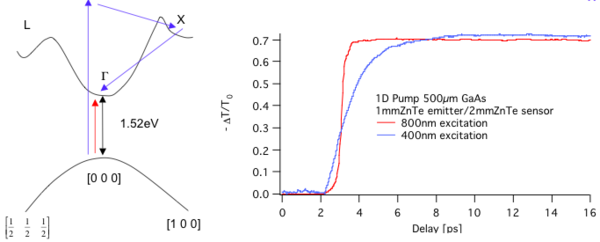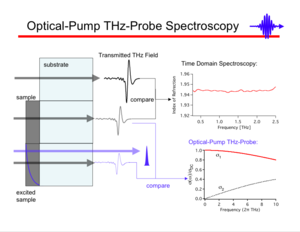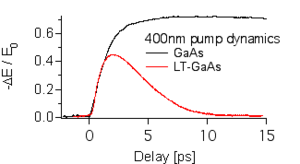Terahertz Radiation
THz defined
THz is Far-Infrared radiation located between microwaves and infrared in the electromagnetic spectrum.
Spectroscopy Applications
THz Time Domain Spectroscopy
The electric field of the THz pulse is sampled via the electrooptic effect in a second order nonlinear material.
The field transmitted through the sample is compared to that transmitted through its substrate (or through free space for free standing samples) and through fourier analysis the frequency dependent index of refraction and absorption coefficients are extracted.
Optical Pump THz Probe Spectroscopy
The THz waveform transmitted through the excited sample is compared to that transmitted through the unexcited sample and through fourier analysis the full frequency dependent complex conductivity can be obtained. Modeling on this photo-induced conductivity yields the mobility and carrier density, also giving the photon-to-carrier yield. Control of the delay between the excitation (the "pump") and the THz pulse (the "probe") provides the time evolution of the photoexcited state.
To extract the complex conductivity we use the following approximate analytic relationship following the work of Sundstrum
- <math>\tilde{\sigma} (\omega) \approx - \frac {(n_{THz} +1 )}{Z_0d}\frac {\Delta \tilde{E}(\omega)}{\tilde{E}_0(\omega)}\,\!</math>
where
- <math>d\,\!</math> is the absorption depth at λexc
Advantages
- Non-contact low energy (meV) non-perturbing optical probe with sub-ps resolution
- Coherent detection provides magnitude and phase of THz waveform, i.e. direct access to the complex dielectric properties of materials under study
- THz radiation is sensitive to charge carriers as carrier scattering times are fs-ps placing the scattering (damping) rate in the THz regime
Carrier Dynamics

This technique has be used to examine carrier dynamics, Drude-like and deviations from the Drude model in popular semiconductors such as semi-insulating (SI-) GaAs
Carrier trapping
It can also be used to identify carrier trapping. The rapid decrease in THz absorption (below) in photoexcited LT-GaAs is due to carrier trapping by As clusters.
We have applied this technique to study carrier dynamics in RR-P3HT and ultrafast charge transfer in the bulk heterojunction P3HT/PCBM 1:1 excited with either 400 nm (3.1 eV) and 800 nm (1.44 eV) light, the results of which are published in J Phys Chem C.
At low temperature there is an increase in the photoconductivity (mobility) of P3HT due to decreased torsoinal disorder which increases the effective conjugation length. The faster recombination dynamics are associated with inhibited interchain hopping at low temperature.
Above: Though there is only very weak absorption at 800 nm, both energy excitations yield similar dynamics on subpicosecond time scales.
Above: Ultrafast electron transfer from P3HT to PCBM is marked by an increase in the long lived photoconductive state in the bulk heterojunction compared to neat films of P3HT.
The extracted complex frequency-dependent conductivty of P3HT exibits characteristics of strong (Anderson) carrier localization and inhibited long range trasport due to disorder (below). Fitting of the conductivity to the Drude-Smith model provides photon-to-carrier yields of < 1.5% and a hole mobility of ~35 cm^2/Vs. The THz regime mobility agrees well with published DFT calculations of the predicted intrinsic hole mobility in well ordered P3HT.
The high frequency THz radiation probes carriers over short (nanoscale) distances, which corresponds to highly ordered domains in this system. Through this experiment we are able to experimentally determine the upper limit of the carrier mobility that would be seen in a device with perfect ordering, instead of the disorder limited mobility typically seen in devices.
See Wikipedia Terahertz Radiation See Wikipedia Terahertz time-domain spectroscopy




